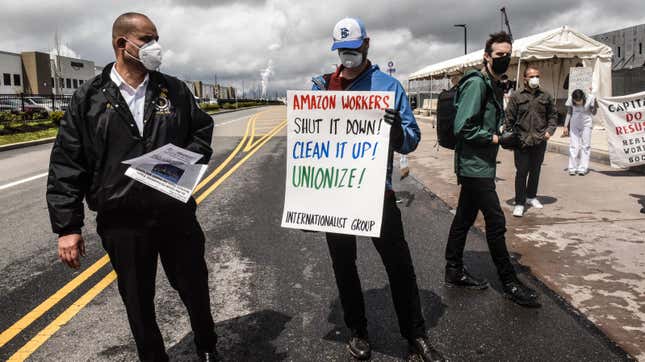
The grassroots Amazon Labor Union is finally gearing up for an election after gathering thousands of worker signatures.
Organizers of the new union, all former and current Amazon workers, set up camp in April outside of Staten Island’s JFK8 distribution center, where they’ve been passing out water and masks and T-shirts and holding barbecues for workers in a tent near the warehouse day and night.
They’re attempting to organize that warehouse as well as three other nearby centers: LDJ5, DYY6, and DYX2. Now the ALU says that, by Monday, it’ll have the required minimum of 30% of workers to sign on to conduct an election through the National Labor Relations Board (NLRB). The ALU says it’s reached over 2,000 sign-ups as of this writing. (The estimated total number of workers in the four workplaces varies, but it’s over 6,000, according to the ALU.)
The failure of the Bessemer, Alabama, union drive in April was disappointing, but the ALU has some advantages over the Retail, Wholesale and Department Store Union (RWDSU), which organized the drive there. It’s new, and it’s organized by local Amazon workers, possibly making it harder for Amazon to convince union voters that it’s a greedy bloated organization that’s just out for dues money.
“Our organizers are seasoned Amazon workers,” ALU President Christian Smalls said over the phone. The ALU’s advantage over an outside union, he said, is for coworkers to spread information amongst themselves.
Smalls emerged as a national figurehead of Amazon organizing after staging a covid-19 safety protest outside the warehouse. He was later fired. Terminating Smalls proved to be a huge mistake for Amazon, which attracted a ton of negative media attention, which made its way to then-CEO Jeff Bezos when he attended an executive meeting discussing a smear campaign that was discovered through notes leaked to Vice News.
New York Attorney General Letitia James filed a lawsuit on Smalls’s and a censured co-organizer’s behalf. (Smalls even flew out to Beverly Hills to protest outside of Bezos’s house.)
“Chris became emblematic of everything that was wrong with Amazon at that time,” Connor Spence, who co-organized the ALU, said in a phone call. “The wrongful terminations, the hazardous working conditions surrounding covid, the blatant racism, especially with the smears—that meeting with Jeff Bezos where they said he’s not smart or articulate.” Spence, who’s been working at one of the nearby warehouses since 2017, said he saw a long-awaited opportunity to start a union drive, and he connect with Smalls and another disciplined protest organizer, Derrick Palmer.
In a statement, the company discouraged unionization by saying it would hamper the company’s ability to act quickly and characterized the union as hampering the relationship between managers and workers, an anti-union description of how collective bargaining empowers workers.
“Our employees have the choice of whether or not to join a union. They always have. As a company, we don’t think unions are the best answer for our employees. Every day we empower people to find ways to improve their jobs, and when they do that we want to make those changes—quickly,” Kelly Nantel, an Amazon spokesperson, said in an email. “That type of continuous improvement is harder to do quickly and nimbly with unions in the middle. The benefits of direct relationships between managers and employees can’t be overstated—these relationships allow every employee’s voice to be heard, not just the voices of a select few. We’ve made great progress in recent years and months in important areas like pay and safety. There are plenty of things that we can keep doing better, and that’s our focus—to keep getting better every day.”
The company did not respond to Gizmodo’s questions regarding the fence, the attorneys, or the flyers.
Amazon workers have gained momentum in mobilizing throughout the pandemic, starting with demands for better covid-19 protections. Workers demanded that in Chicago, and have since staged walkouts demanding better pay and more flexible schedules in the face of the grueling megacycle. Same with workers in New York and Minnesota and Italy, India, and Germany.
Amazon has not handled the swelling worker uprising gracefully. The NLRB has found that Amazon unfairly retaliated against workers who protested in Chicago and New York. The NLRB also found that it violated workers’ rights to a fair union election in Bessemer by installing a USPS mailbox outside the warehouse to collect ballots. Amazon also deployed every union-busting tactic in the book: holding captive audience meetings forcing workers to listen to anti-union propaganda during work hours, photographing workers who asked critical questions, and posting anti-union flyers in the bathrooms. Earlier this month, Smalls tweeted photos of barbed wire fencing between one of the nearby warehouses and the tent, hiding the tent from the workplace.
The ALU says that Amazon attorneys are currently surveying workers during shifts about what they do and don’t like about the job, and a recent tweet shows Amazon-branded propaganda informing workers that “signing a union authorization card may also obligate you to pay the union a monthly fee.” This is a lie. Only joining a union, which is optional, compels people to pay dues.
The ALU plans to file the petition on Monday. Amazon will have the opportunity to respond, then the NLRB will decide whether the election moves ahead.
Update 4:22 p.m. ET: Added statement from Amazon.